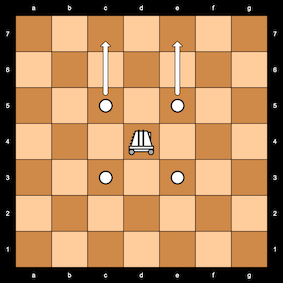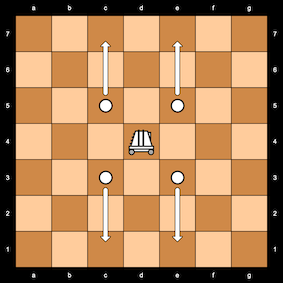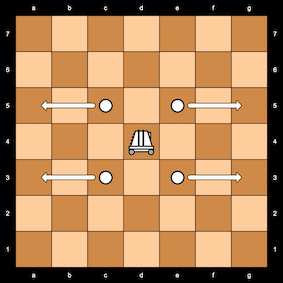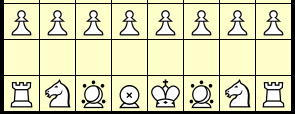Ratings & Comments
 H. G. Muller wrote on Sat, Mar 8 08:49 PM UTC in reply to hirosi Kano from 08:16 PM:
H. G. Muller wrote on Sat, Mar 8 08:49 PM UTC in reply to hirosi Kano from 08:16 PM:The upload also works, if you view it in isolation through the View link in the Comment.
It doesn't work in the Comments list, because of this other Diagram that is on the same page, and links to the betza.js script. If there are multiple links to (different versions of) the Diagram script on the same page, the last one overwrites the earlier ones.
Thanks.
The program worked.
So, did you play my variants?
Please tell me an opinion.
Both Pope & Peer are unbalanced even by CwDA standards. Your Church is Rookish since it has 12 short moves. Replacing the Amazon with your Great Sanctuary or Queen will probably make it more balanced.
Fabricated Ferzes
OK, I will think it over. I commented about 150 pieces and I can use these pieces at will. I love your comments so you would use my pieces freely. I was born in Virgo!!♍️♍️
How can I make the bellow pieces from Betza notation?
Car
????

Ship
????

Train
????

FfyafqF, FyafqF or [F?fqR], FyafzF or [F?fzR].
Here's a link (albeit from August 2024) giving 10 examples of chess AI (all engine-like); it's not stated what the rating of each engine-like chess AI would be, though the ranking of each AI, as listed, is a little bit curious, if it signifies anything. There is a brief comment (towards the end) about a neural network being (somewhat?) not entirely immune to err (in more human-like fashion than an old-fashioned engine) at the play of (games?)/chess, if I recall correctly, but I'm not sure if what is meant is that any such errors that might typically result would be at the least slightly more numerous and/or costlier on average than due to use instead of a now perhaps outdated old-fashioned chess engine:
 H. G. Muller wrote on Fri, Mar 21 06:36 AM UTC in reply to Kevin Pacey from 01:06 AM:
H. G. Muller wrote on Fri, Mar 21 06:36 AM UTC in reply to Kevin Pacey from 01:06 AM:Computer ratings of publicly available AI can be found in the CCRL rating list. Deep Blue was a hardware effort that has long since been dismantled, and could not be tested. It would be weak by today's standards. (It had difficulty winning even a single game against Kasparov; recent engines can afford Knight odds against GM, and would still beat them.)
The order seems random. Some of the mentioned engines are close derivatives of each other. Houdini was a Stockfish clone in the time the latter used 'Hand-Crafted Evaluation'. Latest Stockfish uses Neural Network evaluation. Fat Fritz is an exact clone of it, but trained on a different set of games. (NN have to be trained by millions of examples to be of any use. HCE has to be tuned on position examples as well, but fewer. And it start out at a level that is not completely insane even without tuning, as the tunable parameters have known meaning (like piece values or king safety) and can already be assigned values from chess lore.
Alpha-Zero was a private Google effort using Google server hardware, and thus could not be tested for a rating. Leela Chess Zero is a public implementation of it for PC. It uses a completely different algorithm, using a huge NN, which not only provides evaluation, but also guides a very selective search (which is about 1000 times slower than Stockfish'). It is thought to be much stronger than the original Alpha Zero, through better training. The training takes hundreds of thousands hours of PC time, and was done as a community effort.
Komodo is an engine of similar design to Stockfish, but developed independently.
All AI are of super-human strength as far as recognizing tactics is involved, but they can have strategic misconceptions due to imperfect training/tuning of their evaluation, or using an evaluation design that is simply not able to grasp the required concept. E.g. a HCE that would evaluate material as the sum of fixed piece values will fail to recognize 7 Knights are stronger than 3 Queens, or they would think a Knight is as valuable as a Rook in normal play, depending on the example positions you tune it on. NN are more flexible, but can have blind spots due to absence of sufficiently many examples of a required concept in the training set.
I don't see the relevance of the previous two posts on this topic to piece values. But I'll play.
I think today's AI's should be implemented to be sligtly more general so that they'll play variants. Not very fancy ones, but have knowledge of at least bent riders and hopers over the more easy to program Capablanca pieces. Those could help variant design a lot. That especially when dealing with different armies variants where concepts of piece values are crucial.
@HG,
7N vs 3Q is an extreme case even for variants. I once said that piece values formulas should be multidimentional, at least partially (they are fed in a one value position evaluation, but still). NN do exactly that inherently. Anyway some levelling effect should be somehow taken in the consideration, as your 7N vs 3Q shows, as the leveling effect is something here along with the unorthodox defence between the 7N.
 H. G. Muller wrote on Fri, Mar 21 08:49 AM UTC in reply to Aurelian Florea from 08:20 AM:
H. G. Muller wrote on Fri, Mar 21 08:49 AM UTC in reply to Aurelian Florea from 08:20 AM:NN should in principle be able to use the leveling effect in evaluation. But the problem is that they will never do anything they are not trained to do. If their training set of positions does not contain sufficiently many N Queens vs M Knights with N = 2-3 and M = 3-7 they will essentially just produce random values as evaluation when they are presented such positions. And of course training them on positions from actual Chess games, whether from human game databases or computer games, will not even expose them to a single such position.
Indeed there are much frequent situations for analysing the levelling effect like, as we have both agreed some time ago, Grand Chess in many cases. And I have admited that an "well trained" net should consider that inherently. Of course they should be presented with such situations, but in the case of Grand Chess this should be obvious. On the other hand I do not see leveling effects in Omega Chess. Unless maybe a double queen (through promotion) on one side with say RRBC and maybe an extra pawn for the other. But this should be rare. By the way I have played an officially registered FIDE game the previous weekend where the endgame was BBN+6P vs RR+7 pawns which I had lost with black due to not being able to cross the pawn chain to reach the enemy king. My final point being that the levelling effect is an interesting one to consider. And don't forget that I use the joker in my games which adds two extra layers of leveling. One : imitating stronger pieces is better. Two: Let us call it, for lack of a better name, counter-leveling Imitating a more diverese set of pieces is better (but not as good as point one probably), ie the stronger player would imitate say among mameluk, knight, bishop and siege elephant giving him a lot of choices not to be made by the opponent. Yes, games with joker are complex. :)
I still wish to found something like that
A few days ago, I have played an Apothecary Chess Classic game against Daniel. I have typed the command drawn hopping for a draw offer. Instead, the game suddenly ended in a draw. Where was I wrong?
The "drawn" command is used to end the game after both players agree to a draw. Draw offers can be made in [1] the "conversation section" below a player's move or [2] a Kibbitz Comment like the one I have just added to your game.
It might be possible to restart your game if one of the two players takes back an earlier move - this feature was designed to allow making a new move, so it may not work is the player is repeating the original move. Sorry I can't help more, but I am not very familiar with the changes here in the last decade.
It seems that Asean Chess is missing on the Chess Variants Pages, or am I wrong?
 H. G. Muller wrote on Mon, Apr 7 01:01 PM UTC in reply to M Winther from 12:31 PM:
H. G. Muller wrote on Mon, Apr 7 01:01 PM UTC in reply to M Winther from 12:31 PM:I don't think we have a page on it. As there is an ongoing discussion about originality, it is of some interest to see how I would judge this one. If it was just an invention from one of the members here, I would say: "this only differs from Makruk by the promotion rule (to all pieces on 8th rank rater than to Met at the 6th). This could be easily handled by a remark in the Notes section of the Makruk article!".
As it is we are dealing with an official regional variant, supported by a national association. That in itself makes it imporatant enough to warrant its own article.
BTW, now that you are here: I noticed you have an extensive website on chess variants yourself. Would you be interested in having Interactive Diagrams like we have here (e.g. for Samnis Chess) on that site as well? And could you answer the question I had on the exact move of the Samnis in the Comments there?
The "drawn" command is used to end the game after both players agree to a draw. Draw offers can be made in [1] the "conversation section" below a player's move or [2] a Kibbitz Comment like the one I have just added to your game.
That is correct. Draw offers are made conversationally. The drawn command just draws the game. You should normally be able to catch this in the Preview if it's not what you were expecting.
25 comments displayed
Permalink to the exact comments currently displayed.

The program of preview works well but the one of after upload doesn't work. Do you know why it is?